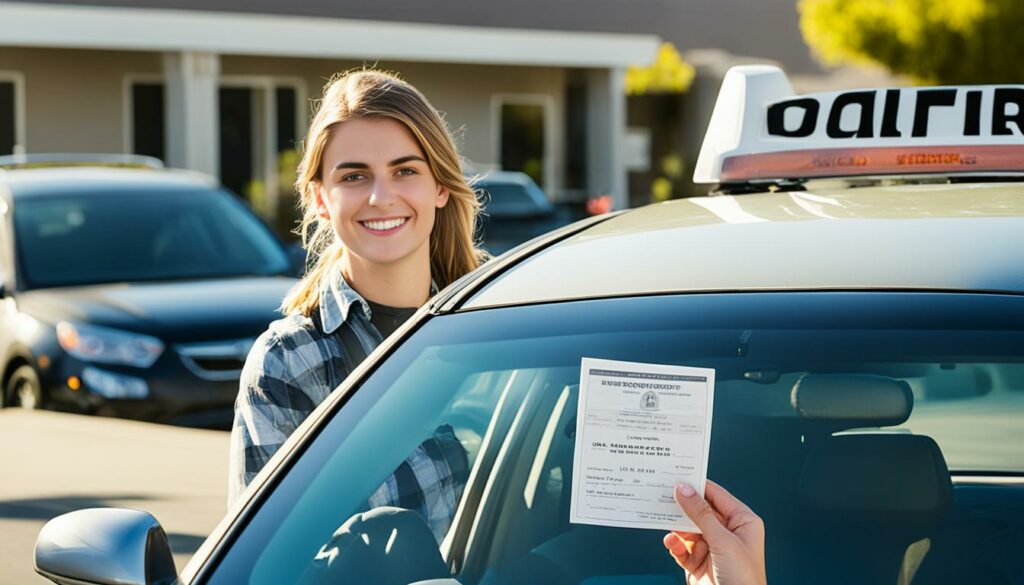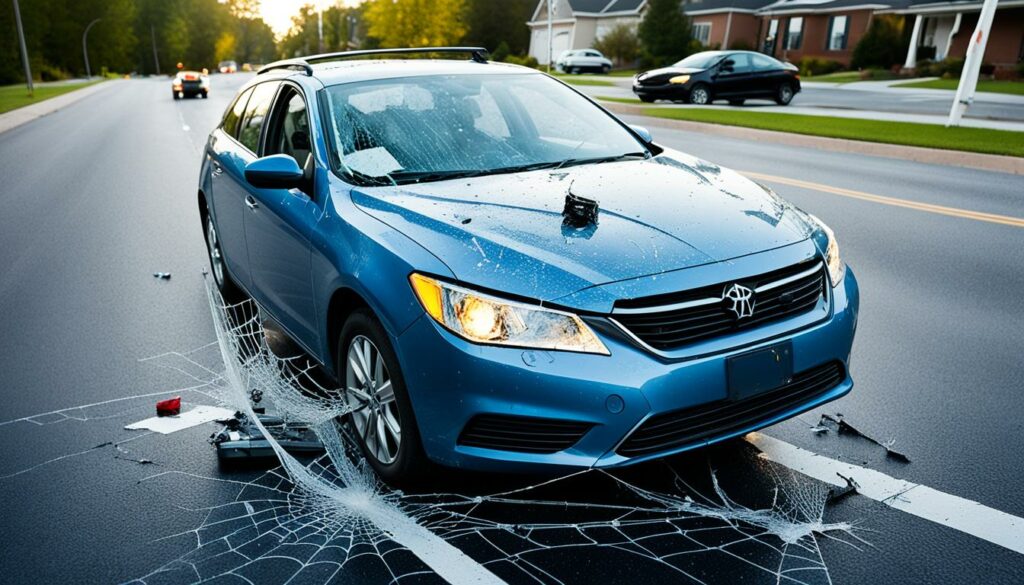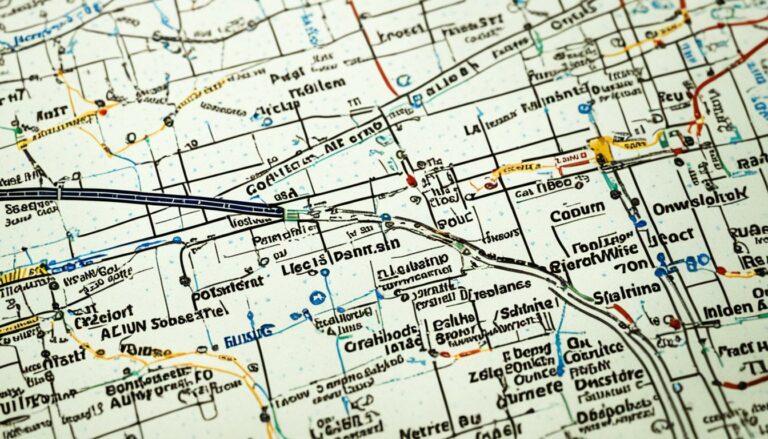Can I Drive My Friends Around at 16? Know the Rules
As a 16-year-old, you may be eager to hit the road with your friends and explore the freedom of driving. However, it’s essential to understand the rules and regulations that govern teenage driving. In this article, we’ll explore the driving laws for 16-year-olds and whether you can drive your friends around at this age.
In California, where the driving laws for teenagers are stringent, there are specific restrictions in place. To obtain a driver’s license, 16-year-olds must have a parent or guardian’s signature, pass various tests, and complete a driver training course. Once licensed, teenage drivers in Sacramento cannot transport passengers under 20 years old without a parent, guardian, or licensed adult over 25 present in the car. There are exceptions for medical necessity, school-authorized activities, employment purposes, and transportation of immediate family members.
Key Takeaways:
- California enforces strict driving restrictions for 16-year-olds, limiting their ability to drive friends.
- Teenage drivers in Sacramento cannot transport passengers under 20 years old without a parent, guardian, or licensed adult over 25 present.
- Exceptions to this rule include medical necessity, school-authorized activities, employment purposes, and transportation of immediate family members.
California Laws About Teenage Drivers

When it comes to driving, teenagers under 18 in Sacramento must adhere to specific rules and regulations. These laws are in place to ensure the safety of young drivers and others on the road. Let’s take a closer look at the California licensed driver laws, restricted license California rules, and teenage driving laws that apply to teenagers in Sacramento.
Driving Curfew and Adult Supervision
One of the key restrictions for teenage drivers in Sacramento is the driving curfew. Teenagers must have adult supervision when driving between 11 p.m. and 5 a.m. This rule helps prevent late-night risky behavior and promotes safer driving practices. By having an adult present during these hours, young drivers have additional guidance and support on the road.
Prohibition on Employment as Drivers
Another important rule for teenage drivers in Sacramento is the prohibition on being employed as drivers of motor vehicles. This restriction ensures that young drivers can fully focus on their driving skills and gaining experience without the added responsibility of transporting others as part of their employment. By prioritizing safety over employment, these laws aim to reduce distractions and potential risks on the road.
Exceptions to the Rules
While there are strict guidelines for teenage drivers in Sacramento, certain exceptions exist for specific situations. For example, if reasonable transportation is not available, if there is a medical necessity (with a note from a physician), for school-authorized activities (with a note from a school official), for employment purposes (with a note from the employer), or for the transportation of immediate family members (with a note from a parent or legal guardian), teenagers may be granted exemptions to the driving restrictions.
| Restrictions | Exceptions |
|---|---|
| Driving between 11 p.m. and 5 a.m. | Reasonable transportation not available |
| Employment as drivers of motor vehicles | Employment purposes (with a note from the employer) |
| Medical necessity (with a note from a physician) | |
| School-authorized activities (with a note from a school official) | |
| Transportation of immediate family members (with a note from a parent or legal guardian) |
It’s crucial for teenage drivers in Sacramento to be aware of and comply with these California laws. By understanding and following these rules, young drivers can contribute to safer roadways and avoid any penalties or consequences associated with violating the restrictions.
Reasons for Teenage Driving Laws

Teenage driving laws have been established for a number of reasons. Statistical data has shown that motor vehicle crashes are the leading cause of death for teenagers in the United States. These laws are designed to address the specific risks associated with teenage driving and promote safer driving practices among young drivers.
The National Highway and Traffic Safety Administration (NHTSA) plays a crucial role in collecting data on teen driving accidents and analyzing the factors that contribute to these accidents. By studying these statistics, policymakers and law enforcement agencies can better understand the challenges faced by teenage drivers and develop effective strategies to mitigate the risks.
Some of the key reasons for implementing teenage driving laws include:
- Reducing risky behavior: Teenagers are more susceptible to engaging in risky behavior while driving, such as speeding, distracted driving, or driving under the influence. The driving restrictions aim to minimize these behaviors and promote responsible driving habits among young drivers.
- Addressing inexperience: Teenagers lack experience behind the wheel, and this lack of experience can impact their ability to handle challenging driving situations, make quick decisions, and react appropriately to potential hazards. The driving laws provide a phased approach to driving, allowing teenagers to gain experience gradually and under adult supervision.
- Protecting passengers: Teenagers often have friends or peers in their vehicles, and the presence of passengers can amplify distractions and increase the risk of accidents. The restrictions on passenger numbers aim to limit the distractions and ensure that young drivers can focus on the road.
- Preventing accidents: By implementing stringent driving restrictions, such as curfews and passenger limits, the aim is to prevent accidents and reduce the chances of injuries or fatalities among teenage drivers and their passengers.
It is important for teenagers, parents, and the community as a whole to understand the necessity of these driving laws and support their implementation. By adhering to these regulations, we can work together to create a safer environment on the roads for our young drivers and reduce the devastating consequences of teen driving accidents.
Teen Driving Laws in Arizona

In Arizona, newly licensed 16-year-old drivers have specific restrictions for the first six months. These laws aim to ensure the safety of young drivers and their passengers on the road. Here are some key regulations that 16-year-old drivers in Arizona must adhere to:
- Driving Time Restrictions: 16-year-old drivers are not allowed to drive between 12 a.m. and 5 a.m. during their probationary period. This restriction helps prevent late-night driving, which is often associated with higher risks for young drivers.
- Seatbelt Requirement: It is mandatory for 16-year-old drivers to ensure that all passengers in their vehicle wear seatbelts. This rule helps promote safety and minimize the potential for injuries in the event of a collision.
- No Hand-held Communication Devices: To minimize distractions while driving, 16-year-old drivers in Arizona are prohibited from using hand-held communication devices such as cell phones while operating a vehicle.
- Passenger Restrictions: During the probationary period, 16-year-old drivers can only have one non-family passenger under the age of 18 in the vehicle, unless a parent or legal guardian is present. This limitation helps reduce distractions and maintain focus on the road.
It is important for 16-year-old drivers in Arizona to understand and comply with these driving laws to ensure their safety and the safety of others on the road. Adhering to these restrictions during the probationary period will help establish good driving habits and contribute to safer roads in Arizona.
Penalties for Teen Driving Violations in Arizona

Teen drivers in Arizona who violate the driving restrictions may face serious penalties and consequences for their actions. It is crucial for young drivers to understand and abide by these restrictions to ensure their safety and the safety of others on the road.
Some of the common violations that can lead to penalties include:
- Speeding: Driving above the posted speed limit is not only dangerous but also against the law. Teen drivers caught speeding may face fines, points on their driving record, and even license suspension.
- Running stop signs or red lights: Disregarding traffic signals puts not only the driver but also pedestrians, passengers, and other motorists at risk. Violating these traffic laws can result in fines, points, and the possibility of increased insurance rates.
- Violating passenger restrictions: Arizona has specific restrictions on the number of passengers teen drivers can have in their vehicles. Violating these restrictions can lead to fines and extended probationary periods. It is essential for teen drivers to follow these rules to prevent distractions and ensure their focus remains on the road.
Depending on the severity of the violation, teen drivers may not only face monetary penalties and license suspension but also longer probationary periods. These consequences are put in place to deter unsafe behavior and promote responsible driving habits among young motorists.
Penalties for Teen Driving Violations
| Violation | Penalties |
|---|---|
| Speeding | Fines, points on driving record, possible license suspension |
| Running stop signs or red lights | Fines, points on driving record, increased insurance rates |
| Violating passenger restrictions | Fines, extended probationary periods |
It is important for teen drivers to recognize that violating these restrictions not only has immediate consequences but can also have long-term impacts on their driving privileges and insurance rates. By adhering to the rules and practicing safe driving habits, young drivers can maintain a clean driving record and ensure their own well-being as well as that of their passengers and other road users.
Minor/Teen Driving Restrictions in Utah
When it comes to driving, minors and teens in Utah are subject to specific driving restrictions. These rules are put in place to ensure the safety of young drivers and those around them. It’s important for both parents and teens to be aware of these restrictions and comply with them. Here are the key driving restrictions for minors and teens in Utah:
Accompanied by a Licensed Driver
- Minors and teens must be accompanied by a licensed driver who is at least 21 years old.
- They can also drive in connection with their employment, a school-sponsored activity, an agricultural operation, or in an emergency.
Learner Permit Requirement
- Minors must carry a learner permit for six months before they can apply for a driver’s license at the age of 16.
- During this period, they are required to complete a driver education course.
Passenger Restrictions
- Minors and teens have passenger restrictions in Utah.
- They are not allowed to have any passengers in the car, except for immediate family members, during the first six months of having a driver’s license.
Driving Hours
- Minors and teens in Utah cannot drive between the hours of 12 a.m. and 5 a.m.
By following these driving restrictions, minors and teens can ensure their safety and the safety of others on the road. It’s important to remember that violating these restrictions can have consequences, including license revocation and extended probationary periods.
Stay informed and drive responsibly to create a safer driving environment for everyone.
Consequences of Violating Utah Teen Driving Restrictions
When teens in Utah disregard the driving restrictions imposed on them, they can face serious consequences. These penalties are put in place to ensure the safety of both the young driver and others on the road. Violations of passenger restrictions and driving during prohibited hours can significantly increase the risk of accidents and endanger lives.
Some of the consequences that teens may face for violating Utah’s teen driving restrictions include:
- License revocation: Teens who repeatedly violate driving restrictions may have their driver’s license revoked, resulting in the loss of their driving privileges. This can have a significant impact on their mobility and daily activities.
- Extended probationary periods: In addition to license revocation, teens who violate driving restrictions may be subject to extended probationary periods. This means that they would need to adhere to stricter driving rules and regulations for a longer period of time.
It is crucial for teens to understand and follow the driving restrictions in place to avoid these penalties. By doing so, they not only comply with the law but also contribute to safer roadways for everyone.
Learner Permit and Graduated Driver Licensing in Utah
In Utah, teens who are eager to start driving can obtain a learner permit at the age of 15. This permit acts as a stepping stone towards getting a driver’s license and allows teens to gain valuable driving experience under certain restrictions. One of the key requirements for obtaining a learner permit is the completion of a driver education course, which equips teens with the knowledge and skills needed to become safe and responsible drivers.
During the six-month period while holding a learner permit, teens must carry it with them whenever they are behind the wheel. This provides proof of their temporary driving privileges and ensures compliance with Utah’s licensing requirements. It’s important to note that parents or legal guardians are responsible for the financial liability of their teen’s driving activities until they turn 18.
To progress from a learner permit to a full driver’s license at the age of 16, teens in Utah must pass a series of tests to demonstrate their driving competency. These tests include an eye test, a written knowledge test, and a driving skills test. The driving skills test evaluates the teen’s ability to handle different driving situations and assesses their understanding of the rules of the road.
“Obtaining a learner permit is a significant milestone for teens on their journey towards becoming licensed drivers in Utah,” explains Sandra Johnson, a Utah Department of Public Safety representative. “It provides them with the opportunity to learn and develop essential driving skills while under the guidance and supervision of a licensed adult.”
“Gaining practical driving experience and passing the required tests are vital steps in ensuring that teen drivers are prepared to navigate Utah’s roads safely,” Johnson continues. “By completing a driver education course and successfully passing the necessary exams, teens can demonstrate their readiness to obtain a driver’s license.”
Utah Learner Permit Requirements:
- Minimum age of 15
- Completion of a driver education course
- Passing an eye test
- Passing a written knowledge test
- Passing a driving skills test
Once teens obtain their driver’s license at the age of 16, certain restrictions still apply during the first six months. For the safety of young drivers and their passengers, teens are not allowed to drive with friends who are not immediate family members during this probationary period. This ensures that new drivers focus on developing their skills and gaining experience without the added distractions that may come with multiple passengers in the car.
The Utah learner permit requirements and the driving skills test aim to equip teen drivers with the knowledge, experience, and responsible behaviors necessary to navigate the roads with confidence. By adhering to these requirements, teens can build a solid foundation for a lifetime of safe and responsible driving.
Driving Laws for Teens in Multiple States
Each state in the United States has its own specific laws and restrictions for teen drivers. These laws, aimed at reducing accidents and promoting safe driving practices among young drivers, vary from state to state. It is crucial for both teens and their parents to be aware of and familiarize themselves with the driving laws in their respective states to ensure compliance and safety on the road.
Conclusion
Teenage driving laws encompass a wide range of restrictions that vary from state to state. These laws are specifically designed to reduce risky behavior and promote safe driving practices among young drivers. It is crucial for both teenagers and their parents to familiarize themselves with these laws and ensure compliance to prioritize their safety as well as the safety of others on the road.
Driving restrictions for teen drivers typically include limitations during the first few months or years of driving. These restrictions may involve mandatory adult supervision during certain hours, limitations on the number of passengers, and prohibitions on driving at night or using communication devices while driving.
By understanding and adhering to these driving laws, teenagers can develop responsible driving habits early on and contribute to the overall improvement of road safety. Remember, compliance with these regulations is essential, as violations may lead to penalties, such as license revocation or extended probationary periods. Stay informed and drive safely!
FAQ
Can I drive my friends around at 16?
The laws regarding driving with friends at the age of 16 vary depending on the state. In some states, there are restrictions on the number of passengers or the presence of an adult in the car. It is important to familiarize yourself with the specific driving laws in your state to ensure compliance.
What are the teenage driving laws in California?
In California, 16-year-olds have specific driving restrictions. They must have a parent or guardian’s signature, pass various tests, and complete a driver training course to obtain a driver’s license. Teenagers in Sacramento cannot transport passengers under 20 years old without a parent, guardian, or licensed adult over 25 present in the car. There are exceptions for medical necessity, school-authorized activities, employment purposes, and transportation of immediate family members.
Why are there teenage driving laws?
Teenage driving laws are based on statistics that show motor vehicle crashes are the leading cause of death for teenagers in the United States. These laws aim to reduce risky behavior and promote safer driving practices among teenage drivers. Organizations like the National Highway and Traffic Safety Administration (NHTSA) collect data on teen driving accidents and provide resources for families affected by car accidents involving teen drivers.
What are the driving restrictions for 16-year-olds in Arizona?
Newly licensed 16-year-old drivers in Arizona have restrictions for the first six months. They are not allowed to drive between 12 a.m. and 5 a.m., must ensure their passengers wear seatbelts, and cannot use hand-held communication devices while driving. For the first six months, they can only have one non-family passenger under 18 in the car, unless a parent or legal guardian is also present. After the six-month probationary period, they are free to safely drive their friends around.
What are the penalties for violating teenage driving restrictions in Arizona?
Teen drivers in Arizona who violate driving restrictions may have their driver’s license revoked and face other penalties. Violations such as speeding, running stop signs or red lights, and violating passenger restrictions can result in extended probationary periods and license revocation. It is important for teen drivers to follow these restrictions to ensure their safety and the safety of others on the road.
What driving restrictions apply to minors and teens in Utah?
In Utah, minors and teens must be accompanied by a licensed driver at least 21 years old or be driving in connection with their employment, a school-sponsored activity, an agricultural operation, or in an emergency. Minors must carry a learner permit for six months before applying for a driver’s license at the age of 16 and complete a driver education course. They also have passenger restrictions and cannot drive between 12 a.m. and 5 a.m.
What are the consequences for violating teen driving restrictions in Utah?
Teens in Utah who violate driving restrictions can face penalties such as license revocation and extended probationary periods. It is important to follow these restrictions to ensure the safety of the teen driver and others on the road. Violating passenger restrictions and driving during prohibited hours can increase the risk of accidents and endanger lives.
What are the requirements for obtaining a learner permit and driver’s license in Utah?
Teens in Utah can obtain a learner permit at the age of 15 and must carry it for six months before applying for a driver’s license at 16. They are required to complete a driver education course and pass an eye test, written knowledge test, and driving skills test. Parents are responsible for financial responsibility until the teen turns 18. During the first six months of having a license, teens cannot drive with friends who are not immediate family members.
What are the driving laws for teens in multiple states?
Each state in the United States has its own specific laws and restrictions for teen drivers. These laws aim to reduce accidents and promote safe driving practices among young drivers. It is important for teens and their parents to familiarize themselves with the driving laws in their state to ensure compliance and safety on the road.
What are the key points to know about teenage driving laws?
Teenage driving laws vary by state and often include specific restrictions for the first few months or years of driving. These restrictions aim to reduce risky behavior and promote safe driving practices among young drivers. It is important for teens and their parents to understand and follow these laws to ensure their safety and the safety of others on the road.







